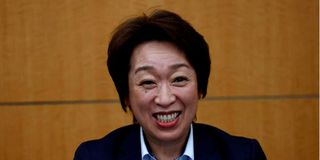Altered Tokyo Olympic board can aptly show worth of women

President of the Tokyo 2020 Olympics Organising Committee Seiko Hashimoto smiles before the start of opening remarks session of the press briefing on operation and media coverage of Tokyo 2020 Olympic Torch Relay in Tokyo on February 25, 2021.
What you need to know:
- One bloc assumes that gender equality can be achieved, the other that it can’t. The latter thinks the former is chasing an impossible utopia. The former thinks the utopia could be achieved if only everyone pulled together.
The world is cleaved in two, with each bloc operating according to a different set of assumptions.
One bloc assumes that gender equality can be achieved, the other that it can’t. The latter thinks the former is chasing an impossible utopia. The former thinks the utopia could be achieved if only everyone pulled together.
If you observe the goings on in Tokyo, the city that will host the Olympics this year, you may see these opposing forces in play. What an irony, that an organisation as established and respected as the Olympics committee couldn’t take fair gender representation seriously, early enough.
Up until Wednesday this week when a newly constituted 2020 Tokyo Olympics Games organising committee was officially unveiled, the previous one led by disgraced politician Yoshiro Mori comprised of only seven women, translating to just 20 per cent of the 34-member board.
Under new president Seiko Hashimoto, who has appointed 12 new female members, women now account for about 42 per cent in the new committee.
Prior to Wednesday’s unveiling, Seiko told media that the board’s decision was “important to restore people’s trust.” You see, her predecessor had brought shame to the organisation and to all sports stakeholders in Japan by uttering sexist remarks which were later leaked by the Japanese media.
Seiko is a Japanese politician, former speed skater and track cyclist. She has the second most Olympic appearances of any Japanese athlete, and has represented her country both in the summer and winter Olympics.
She is currently a member of the House of Councillors, serves as the President of the Japan Skating Federation and is affiliated to revisionist Nippon Kaigi.
Prior to her appointment, she served on the Japanese cabinet as Minister of State for the Tokyo Olympic and Paralympic Games.
One hopes that Seiko’s decorated resume will enable her to succeed where her male counterparts failed.
One of her predecessor’s last statements before resigning was that should the number of female board members increase, they would have to “make sure their speaking time is restricted somewhat, they have difficulty finishing, which is annoying”.
We won’t know for some time – perhaps years – the extent to which Mori was right, because of the need to assess video and audio recordings of meetings involving the newly constituted board.
Perhaps the meetings will be longer, as Mori predicted, but maybe they will be shorter since the women on the board won’t “talk too much” in an attempt to prove their worth.
Whatever the case, it feels good and encouraging to have a woman assume that role for the first time in the history of Japan and that of many other countries.
The world awaits lessons from the Seiko-led committee. I will be among those taking important notes throughout the committee’s tenure.
I pray that Seiko will step up early and hard, kicking open previously closed doors and eventually proving that she is indeed worth her weight.




